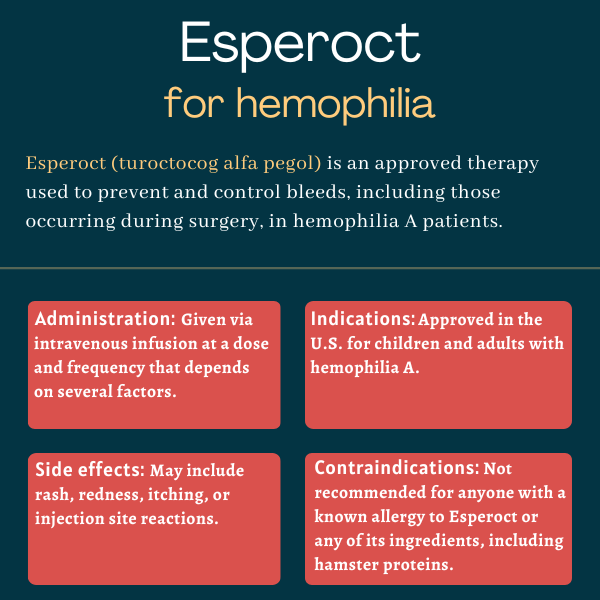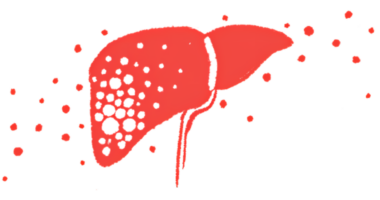Esperoct (turoctocog alfa pegol) for hemophilia
What is Esperoct for hemophilia?
Esperoct (turoctocog alfa pegol) is an approved treatment for adults and children with hemophilia A. It can be used routinely to prevent bleeding episodes (prophylaxis), to stop an active bleed (on-demand), or to manage bleeds occurring around the time of surgery (perioperative management).
The therapy, developed by Novo Nordisk, is administered via an intravenous, or into-the-vein, infusion.
Therapy snapshot
| Brand name: | Esperoct |
| Chemical name: | Turoctocog alfa pegol |
| Usage: | Prevention and treatment of bleeds, including those occurring during surgery, in hemophilia A patients |
| Administration: | Intravenous infusion |
How does Esperoct work?
Hemophilia A patients lack a blood clotting protein called factor VIII (FVIII) due to mutations in the F8 gene, leading to hallmark disease symptoms of spontaneous and excessive bleeding.
Esperoct is an FVIII replacement therapy which provides patients with a lab-made version of the FVIII protein. It is an extended-half life product, which means it’s modified to last longer in the body compared with standard FVIII products.
To achieve this, Esperoct contains a modified version of FVIII that is attached to a molecule called polyethylene glycol (PEG). PEG helps decrease the therapy’s excretion, or elimination, in the kidneys and slows the pace at which it is broken down, allowing it to remain in circulation for longer periods of time.
When Esperoct is activated at the site of a bleed, the PEG molecule is cleaved off, leaving active FVIII to help control bleeding.
Who can take Esperoct?
Esperoct was approved by the U.S. Food and Drug Administration (FDA) in February 2019 for the prevention and treatment of bleeds, including those occurring during surgery, in adults and children with hemophilia A.
The therapy is similarly approved in Canada. In Europe, Esperoct is approved for hemophilia A patients, ages 12 and older.
Who should not take Esperoct?
Esperoct is contraindicated, or not recommended, for patients with a known sensitivity to the therapy or any of its ingredients, including hamster proteins.
The therapy also is not indicated for the treatment of von Willebrand disease, another inherited bleeding disorder.
How is Esperoct administered?
Esperoct is administered as into-the-vein (intravenous) infusions that take about two minutes each. The therapy may be self-administered or given by a caregiver after proper training by a healthcare provider or at a hemophilia treatment center.
It comes as a white to off-white powder in single-use vials at various dose strengths that must be reconstituted, or diluted, in 4 mL of a saline diluent prior to infusion.
Each vial is labeled and color-coded according to its dosage in international units (IUs):
- Red: 500 IU
- Green: 1,000 IU
- Gray: 1,500 IU
- Yellow: 2,000 IU
- Black: 3,000 IU
- Light pink: 4,000 IU
- Dark blue: 5,000 IU.
The recommended dose of Esperoct will depend on several factors, including the severity of FVIII deficiency, location and extent of bleeding, and the patient’s clinical condition, as well as whether the therapy is being used preventively, on-demand, or perioperatively.
For routine prophylaxis, the recommended starting dose of Esperoct for adolescents and adults ages 12 and older is 50 IU per kilogram of body weight (IU/kg) every four days.
For children younger than 12, the recommended dose of Esperoct for prophylaxis is 65 IU/kg twice weekly. The frequency of the therapy’s prophylactic regimen may be adjusted by a doctor based on bleed control or other clinical factors.
For on-demand treatment, Esperoct’s dose is calculated based on a patient’s age and the severity of the bleed.
- For minor and moderate bleeds, such as mild muscle or oral bleeds, or more extensive joint bleeds, Esperoct should be given at a dose of 40 IU/kg in adolescents and adults ages 12 and older, and at a dose of 65 IU/kg in children younger than 12. While a single dose of the medication should be sufficient to control mild bleeds, an additional dose given after 24 hours may be required to control moderate bleeds.
- For major bleeds, such as life-threatening bleeds or those occurring in the brain or gastrointestinal tract, Esperoct should be given at a dose of 50 IU/kg in adolescents and adults ages 12 and older, and at a dose of 65 IU/kg in children younger than 12. Additional doses of the medication may be given every 24 hours as needed in these cases.
For perioperative management, the dose of Esperoct is adjusted based on patients’ age and the scale of the surgery.
In adults and adolescents undergoing minor surgery, such as tooth extraction, a pre-operative dose of 50 IU/kg is recommended; in children younger than 12, a pre-operative dose of 65 IU/kg is recommended. Additional doses of Esperoct may be given after a period of 24 hours if needed.
In adults and adolescents undergoing major surgeries, such as joint replacement surgery or those involving the brain, a pre-operative dose of 50 IU/kg is recommended; in children younger than 12, a pre-operative dose of 65 IU/kg is recommended. Additional doses of Esperoct may be given every 24 hours during the first week, and then about every 48 hours until wound healing is achieved.
Esperoct may be given by a healthcare professional at a hospital or at an infusion center. In some cases, patients and caregivers may be able to infuse the therapy after receiving special training. Patients should not attempt to self-infuse without being taught by a healthcare provider.

Esperoct in clinical trials
Esperoct’s safety and efficacy were evaluated in the Pathfinder clinical trial program involving previously treated children, adolescents, and adults with hemophilia A, who were given the therapy preventively, on-demand, or around the time of surgery.
Trial results generally indicated that Esperoct was effective when used as a preventive treatment and to control active bleeds in children and adults.
Pathfinder 1 trial
A Phase 1 dose-escalation trial called Pathfinder 1 (NCT01205724) evaluated the safety and pharmacological properties of Esperoct in 26 people with severe hemophilia A, who each received one of three doses of the therapy (25, 50, or 75 IU per kg).
Trial results showed the treatment was well tolerated at all doses, with none of the participants developing inhibitors — a type of neutralizing antibody — against the therapy. Esperoct’s mean half-life was 19 hours, with the therapy remaining in circulation 1.6 times longer when compared with standard FVIII products that patients had used previously. A therapy’s half-life refers to the amount of time it takes for its levels to drop to half of those originally administered; the longer the half-life, the longer a therapy remains in circulation in the body.
Pathfinder 2 trial
The global and open-label Phase 3 Pathfinder 2 trial (NCT01480180) evaluated the safety, pharmacological properties, and effectiveness of Esperoct as a preventive and on-demand treatment in 186 people with severe hemophilia A, ages 12 and older.
In the trial’s main phase, most participants (175 people) received Esperoct as a prophylactic treatment (50 IU/kg) every four days for about 1.5 years. This was followed by an optional extension phase in which participants were randomly assigned to receive Esperoct once every four days (50 IU/kg) or once weekly (75 IU/kg).
Results from the main trial showed the median annual bleed rate was just over one bleed per year for patients on prophylactic treatment, with 70 of them experiencing no bleeds. Overall, 83.6% of bleeds were resolved with a single infusion of Esperoct and 95.5% with up to two infusions. The treatment was generally well tolerated, with one case of inhibitor development.
By the end of the extension, patients had been treated for up to 6.6 years. Nearly 30% experienced no bleeds across the entire trial, with an estimated annual bleed rate of 2.14 in those treated every four days, and 1.31 in the once weekly treatment group.
Pathfinder 5 trial
Another Phase 3 trial, called Pathfinder 5 (NCT01731600), evaluated the safety and efficacy of Esperoct as a preventive treatment in children younger than age 12 with severe hemophilia A. Patients received twice weekly injections for about six months, and then were given the option to continue treatment in an extension phase, totaling up to 5.4 years of treatment.
Over a median of 4.9 years on Esperoct, the overall estimated annualized bleed rate was 1.08, with 19.1% of these young patients experiencing no bleeds across the entire trial. Therapy safety in children was similar to that reported in adults and adolescents.
Additional analyses of Pathfinder 2 and Pathfinder 5 data found that Esperoct maintained or improved health-related life quality and treatment satisfaction in children, adolescents, and adults.
Pathfinder 3 trial
Pathfinder 3 (NCT01489111) assessed Esperoct’s effectiveness at controlling bleeds in around 30 Pathfinder 2 participants who required surgery during the trial.
A combined analysis of these patients and about 20 children from Pathfinder 5 who also required surgery indicated that Esperoct was effective at controlling bleeds associated with major or minor surgical procedures.
Pathfinder 8 trial
Another Phase 3 trial, called Pathfinder 8 (NCT03528551), assessed the long-term safety and efficacy of Esperoct in severe hemophilia A patients of all ages, given the medication while participating in Pathfinder 2 or Pathfinder 5. Patients received prophylactic treatment with Esperoct, which was administered once, twice, or three times each week for up to 104 weeks (about two years).
In total, 160 patients — 102 from Pathfinder 2 and 58 from Pathfinder 5 — enrolled in Pathfinder 8. The estimated mean annualized bleed rate for all bleeds, excluding those associated with surgery, across all dosing regimens was 1.10. More than half (55.6%) of the patients in Pathfinder 8 experienced no bleeds that warranted treatment with a FVIII product during the study, again apart from perioperative bleeds. No one developed inhibitors during the trial or discontinued treatment due to adverse events.
Pathfinder 6 trial
A global Phase 3 trial called Pathfinder 6 (NCT02137850) assessed the safety and efficacy of Esperoct in children with severe hemophilia A who had never been treated with an FVIII product. The study’s main goal was to assess the proportion of patients developing FVIII inhibitors.
An end-of-trial analysis of Pathfinder 6 showed that 30% of evaluable patients had developed inhibitors, a value that was within the expected range. Findings also suggested Esperoct was effective at preventing and treating bleeds, with evaluable children in Pathfinder 6 having a median annualized bleed rate similar to that previously reported in children treated with Esperoct in Pathfinder 5.
Common side effects of Esperoct
The most common side effects reported in clinical trials of Esperoct include:
- rash
- redness
- itching
- injection site reactions.
In previously untreated patients, the most common side effects reported include:
- development of FVIII inhibitors
- allergic reactions.
Allergic reactions
Allergic reactions are possible in patients using Esperoct. The medication contains trace amounts of hamster proteins, which can cause allergic reactions in some patients.
Early signs of an allergic reaction may include hives, chest tightness, wheezing, dizziness, difficulty breathing, or swelling. If left untreated, these symptoms can progress to serious and life-threatening complications, such as anaphylaxis.
If such signs or symptoms occur, patients should let a healthcare provider know right away, and Esperoct should be discontinued.
Development of inhibitors
Some people using Esperoct may develop inhibitors, a type of neutralizing antibody against FVIII that can make the therapy less effective. If bleeding is not adequately controlled with the recommended dose of Esperoct or the expected FVIII activity levels are not reached, patients should be tested for the presence of inhibitors.
Decreased incremental recovery
Incremental recovery refers to the phenomenon in which FVIII activity levels in the bloodstream increase by a certain amount following the administration of Esperoct. A temporary reduction in incremental recovery, meaning that FVIII activity levels failed to rise as much as expected after treatment, has been observed in previously untreated children without FVIII inhibitors.
In cases where bleeding is not controlled or the expected FVIII activity levels are not attained despite the absence of FVIII inhibitors, doctors may consider adjusting the dose or dosing frequency of Esperoct, or discontinuing treatment.
Use in pregnancy and breastfeeding
There are no data related to the use of Esperoct in pregnant or breastfeeding women. Additionally, no animal studies have evaluated the therapy’s effects on fertility or fetal development, so it is not known whether Esperoct can affect reproduction or cause harm to a developing fetus. Also not known is whether Esperoct can pass into breast milk, impact milk production, or have a negative effect on a breastfed infant.
Patients who are pregnant, breastfeeding, or who plan to become pregnant or breastfeed while using Esperoct should discuss their status or plans with their healthcare team.
Hemophilia News Today is strictly a news and information website about the disease. It does not provide medical advice, diagnosis or treatment. This content is not intended to be a substitute for professional medical advice, diagnosis, or treatment. Always seek the advice of your physician or other qualified health provider with any questions you may have regarding a medical condition. Never disregard professional medical advice or delay in seeking it because of something you have read on this website.
Recent Posts
Related articles

 Fact-checked by
Fact-checked by 



